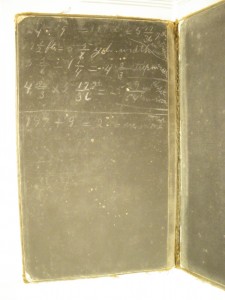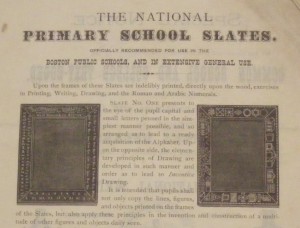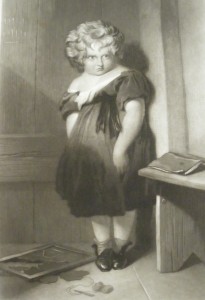With the pending release of Apple Computers’ tablet computer and the surrounding press and discussion, it seemed like a good time to review the precursor to it all, the humble school slate. The Antiquarian Society has several nineteenth-century slates in the games collection, including one  with multiple pages, patented in 1867 and bound like a book. These small objects were used in schools for spelling and mathematical exercises and featured a surface that could support erasure and re-writing. Some were made of actual stone slate, others, like the one pictured here, were paper or paperboard treated with a slate-infused pigment. The selling points for a good-quality school slate might be recognized by today’s computer-savvy consumer: the size of the writing surface, the portability of the object, and the durability over time. Most salesmen’s texts and advertisements promote these qualities. At rates of $1 to $2 per dozen, the school slate was cheap enough that it was widely disseminated and used by thousands of school children across the country.
with multiple pages, patented in 1867 and bound like a book. These small objects were used in schools for spelling and mathematical exercises and featured a surface that could support erasure and re-writing. Some were made of actual stone slate, others, like the one pictured here, were paper or paperboard treated with a slate-infused pigment. The selling points for a good-quality school slate might be recognized by today’s computer-savvy consumer: the size of the writing surface, the portability of the object, and the durability over time. Most salesmen’s texts and advertisements promote these qualities. At rates of $1 to $2 per dozen, the school slate was cheap enough that it was widely disseminated and used by thousands of school children across the country.
Where did all that slate come from? Before the Civil War, slate was m ined in New York, New England and throughout the Mid-Atlantic states. As the population moved westward, slate deposits were recorded and mined right the way across the continent to California. Also used as a roofing and paving material, slate was in high demand through about 1900.
ined in New York, New England and throughout the Mid-Atlantic states. As the population moved westward, slate deposits were recorded and mined right the way across the continent to California. Also used as a roofing and paving material, slate was in high demand through about 1900.
Let’s keep thinking like those executives at Apple. What about the market? In the nineteenth century, school slate manufacturers tried to capture market share in several ways. They created decorative frame styles to appeal to customers, they sold their slates directly to schools to get children used to them (sound like a familiar strategy?), and they offered accompanying items like chalk pencils, cleaners, and rubberized tips to protect the corners of the slate. To help create demand, schoolbook publishers often included in their texts sections designated as “for the slate,” which include suggestions for teachers and students to improve their hand writing, mathematical calculating skills, etc.
several ways. They created decorative frame styles to appeal to customers, they sold their slates directly to schools to get children used to them (sound like a familiar strategy?), and they offered accompanying items like chalk pencils, cleaners, and rubberized tips to protect the corners of the slate. To help create demand, schoolbook publishers often included in their texts sections designated as “for the slate,” which include suggestions for teachers and students to improve their hand writing, mathematical calculating skills, etc.
 So, go ahead and enjoy your tablet computer (or the tablet that belongs to the student in your life)! Now you know that you are following in the footsteps of American consumers well before your time, folks who wanted a smooth surface to write on during class. Just remind your kids to be gentle with their new technology and not to be like the “naughty boy” in the 1845 gift book illustration pictured here. In a fit of pique, he has apparently thrown his slate to the floor of the schoolhouse and it lies there, broken in a million pieces. Alas, there is no evidence that manufacturers ever offered extended warranties on nineteenth-century school slates!
So, go ahead and enjoy your tablet computer (or the tablet that belongs to the student in your life)! Now you know that you are following in the footsteps of American consumers well before your time, folks who wanted a smooth surface to write on during class. Just remind your kids to be gentle with their new technology and not to be like the “naughty boy” in the 1845 gift book illustration pictured here. In a fit of pique, he has apparently thrown his slate to the floor of the schoolhouse and it lies there, broken in a million pieces. Alas, there is no evidence that manufacturers ever offered extended warranties on nineteenth-century school slates!

Too young for slate here, but I miss my Mystic Writing Pad.
Hi there, all the time i used to check weblog posts here early in the dawn, since
i enjoy to learn more and more.
Thanks for your interest!